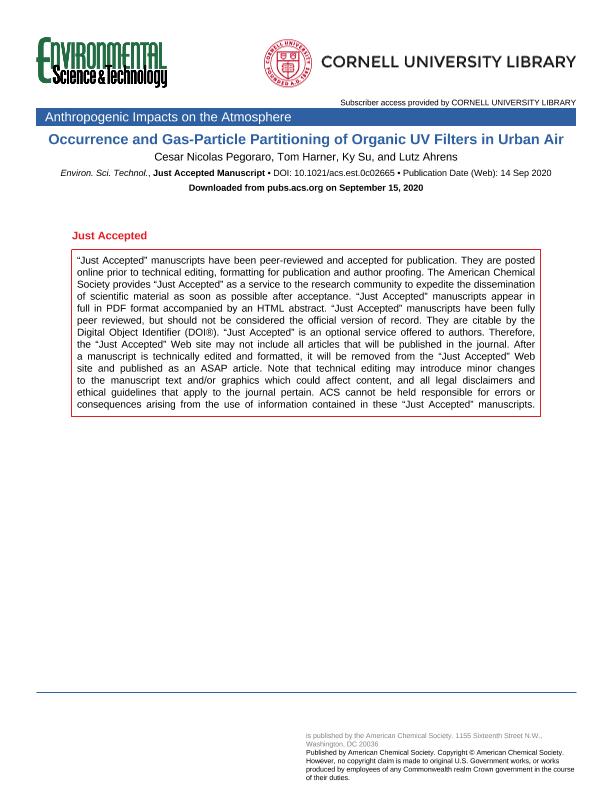Mostrar el registro sencillo del ítem
dc.contributor.author
Pegoraro, César Nicolás

dc.contributor.author
Harner, Tom
dc.contributor.author
Su, Ky
dc.contributor.author
Ahrens, Lutz
dc.date.available
2021-09-08T14:34:16Z
dc.date.issued
2020-09
dc.identifier.citation
Pegoraro, César Nicolás; Harner, Tom; Su, Ky; Ahrens, Lutz; Occurrence and Gas-Particle Partitioning of Organic UV Filters in Urban Air; American Chemical Society; Environmental Science & Technology; 54; 20; 9-2020; 12881-12889
dc.identifier.issn
0013-936X
dc.identifier.uri
http://hdl.handle.net/11336/139895
dc.description.abstract
A retrospective analysis of a comprehensive series of high-volume air samples (n = 70) collected during 2010-2011 in Toronto (Canada) was performed. Seven UV compounds were analyzed by gas chromatography-tandem mass spectrometry (GC-MS/MS) with sum of concentrations (gas + particle phase) ranging from 80 to 2030 pg/m3. Homosalate (HMS) was the most prevalent organic UV-filter in air (47% of the total concentration), followed by 2-ethylhexyl salicylate (EHS, ∼29%), E- and Z-2-ethylhexyl 4-methoxycinnamate (EHMC, ∼17%). Ambient air (gas + particle phase) concentrations of organic UV-filters showed a strong seasonality, with peak levels during the summer. An analysis of Clausius-Clapeyron slopes indicated that much of the ambient burden of organic UV-filters are explained by volatilization from terrestrial and aquatic surfaces and supplemented with human activities and use of lotions and sunscreens, containing organic UV-filters, in addition to its use in plastics, textiles, paints, and pesticides. The results showed that organic UV-filters exist mainly in the gas phase with some exceptions, for instance, octocrylene (OCR), which was associated with both gas and particle phases, and avobenzone (AVB), which was predominantly in the particle phase. Lastly, this study revealed the need for basic physical chemical property data for organic UV-filters, including information on transformation rates and products, for better evaluating their environmental fate and effects.
dc.format
application/pdf
dc.language.iso
eng
dc.publisher
American Chemical Society

dc.rights
info:eu-repo/semantics/openAccess
dc.rights.uri
https://creativecommons.org/licenses/by-nc-sa/2.5/ar/
dc.subject
ORGANIC UV FILTERS
dc.subject
ACTIVE AIR SAMPLING
dc.subject
GAS-PARTICLE PARTITIONING
dc.subject
SEASONAL VARIATIONS
dc.subject.classification
Otras Ciencias de la Tierra y relacionadas con el Medio Ambiente

dc.subject.classification
Ciencias de la Tierra y relacionadas con el Medio Ambiente

dc.subject.classification
CIENCIAS NATURALES Y EXACTAS

dc.title
Occurrence and Gas-Particle Partitioning of Organic UV Filters in Urban Air
dc.type
info:eu-repo/semantics/article
dc.type
info:ar-repo/semantics/artículo
dc.type
info:eu-repo/semantics/publishedVersion
dc.date.updated
2021-08-27T20:27:03Z
dc.journal.volume
54
dc.journal.number
20
dc.journal.pagination
12881-12889
dc.journal.pais
Estados Unidos

dc.journal.ciudad
Washington
dc.description.fil
Fil: Pegoraro, César Nicolás. Universidad Nacional de Mar del Plata. Facultad de Ciencias Exactas y Naturales. Departamento de Química; Argentina. Consejo Nacional de Investigaciones Científicas y Técnicas. Centro Científico Tecnológico Conicet - Mar del Plata. Instituto de Investigaciones Biológicas. Universidad Nacional de Mar del Plata. Facultad de Ciencias Exactas y Naturales. Instituto de Investigaciones Biológicas; Argentina
dc.description.fil
Fil: Harner, Tom. Environment And Climate Change Canada; Canadá
dc.description.fil
Fil: Su, Ky. Environment And Climate Change Canada; Canadá
dc.description.fil
Fil: Ahrens, Lutz. Swedish University Of Agricultural Sciences; Suecia
dc.journal.title
Environmental Science & Technology

dc.relation.alternativeid
info:eu-repo/semantics/altIdentifier/url/https://pubs.acs.org/doi/10.1021/acs.est.0c02665
dc.relation.alternativeid
info:eu-repo/semantics/altIdentifier/doi/http://dx.doi.org/10.1021/acs.est.0c02665
Archivos asociados
